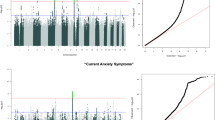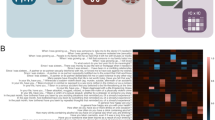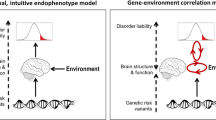Abstract
Depression and anxiety are highly prevalent and comorbid psychiatric traits that cause considerable burden worldwide. Here we use factor analysis and genomic structural equation modelling to investigate the genetic factor structure underlying 28 items assessing depression, anxiety and neuroticism, a closely related personality trait. Symptoms of depression and anxiety loaded on two distinct, although highly genetically correlated factors, and neuroticism items were partitioned between them. We used this factor structure to conduct genome-wide association analyses on latent factors of depressive symptoms (89 independent variants, 61 genomic loci) and anxiety symptoms (102 variants, 73 loci) in the UK Biobank. Of these associated variants, 72% and 78%, respectively, replicated in an independent cohort of approximately 1.9 million individuals with self-reported diagnosis of depression and anxiety. We use these results to characterize shared and trait-specific genetic associations. Our findings provide insight into the genetic architecture of depression and anxiety and comorbidity between them.
This is a preview of subscription content, access via your institution
Access options
Access Nature and 54 other Nature Portfolio journals
Get Nature+, our best-value online-access subscription
$29.99 / 30 days
cancel any time
Subscribe to this journal
Receive 12 digital issues and online access to articles
$119.00 per year
only $9.92 per issue
Buy this article
- Purchase on Springer Link
- Instant access to full article PDF
Prices may be subject to local taxes which are calculated during checkout





Similar content being viewed by others
Data availability
All GWAS summary statistics generated from UK Biobank data are available from the authors upon request. Individual-level data for UK Biobank participants are available to eligible researchers through the UK Biobank (www.biobank.ac.uk). Access to 23andMe data is available upon request to 23andMe (further information is available from https://research.23andme.com/collaborate/).
Code availability
Code used to conduct analyses presented in this manuscript is available from the authors upon reasonable request.
References
Vigo, D., Thornicroft, G. & Atun, R. Estimating the true global burden of mental illness. Lancet Psychiatry 3, 171–178 (2016).
Depression and Other Common Mental Disorders: Global Health Estimates (World Health Organization, 2017).
Lamers, F. et al. Comorbidity patterns of anxiety and depressive disorders in a large cohort study: the Netherlands study of depression and anxiety (NESDA). J. Clin. Psychiatry 72, 341–348 (2011).
Hettema, J. M., Neale, M. C. & Kendler, K. S. A review and meta-analysis of the genetic epidemiology of anxiety disorders. Am. J. Psychiatry 158, 1568–1578 (2001).
Sullivan, P. F., Neale, M. C. & Kendler, K. S. Genetic epidemiology of major depression: review and meta-analysis. Am. J. Psychiatry 157, 1552–1562 (2000).
Middeldorp, C. M., Cath, D. C., Van Dyck, R. & Boomsma, D. I. The co-morbidity of anxiety and depression in the perspective of genetic epidemiology. A review of twin and family studies. Psychol. Med. 35, 611–624 (2005).
McCrae, R. R. & Costa, P. T. Updating Norman’s “adequacy taxonomy”: intelligence and personality dimensions in natural language and in questionnaires. J. Pers. Soc. Psychol. 49, 710–721 (1985).
Eysenck, H. J. & Eysenck, M. W. Personality and Individual Differences: A Natural Science Approach (Plenum, New York, NY, 1985).
Kotov, R., Gamez, W., Schmidt, F. & Watson, D. Linking “big” personality traits to anxiety, depressive, and substance use disorders: a meta-analysis. Psychol. Bull. 136, 768–821 (2010).
Gray, J. A. & McNaughton, N. The Neuropsychology of Anxiety. An Enquiry into the Functions of the Septo-Hippocampal System (Oxford Univ. Press, Oxford, 2000).
Ormel, J. et al. Neuroticism and common mental disorders: meaning and utility of a complex relationship. Clin. Psychol. Rev. 33, 686–697 (2013).
Zinbarg, R. E. et al. Testing a hierarchical model of neuroticism and its cognitive facets: latent structure and prospective prediction of first onsets of anxiety and unipolar mood disorders during 3 years in late adolescence. Clin. Psychol. Sci. 4, 805–824 (2016).
Vukasović, T. & Bratko, D. Heritability of personality: a meta-analysis of behavior genetic studies. Psychol. Bull. 141, 769–785 (2015).
Hettema, J. M., Prescott, C. A. & Kendler, K. S. Genetic and environmental sources of covariation between generalized anxiety disorder and neuroticism. Am. J. Psychiatry 161, 1581–1587 (2004).
Jardine, R., Martin, N. G. & Henderson, A. S. Genetic covariation between neuroticism and the symptoms of anxiety and depression. Genet. Epidemiol. 1, 89–107 (1984).
Fanous, A., Gardner, C. O., Prescott, C. A., Cancro, R. & Kendler, K. S. Neuroticism, major depression and gender: a population-based twin study. Psychol. Med. 32, 719–728 (2002).
Hettema, J. M., Neale, M. C., Myers, J. M., Prescott, C. A. & Kendler, K. S. A population-based twin study of the relationship between neuroticism and internalizing disorders. Am. J. Psychiatry 163, 857–864 (2006).
Purves, K. L. et al. A major role for common genetic variation in anxiety disorders. Mol. Psychiatry 25, 3292–3303 (2020).
Meier, S. M. et al. Genetic variants associated with anxiety and stress-related disorders: a genome-wide association study and mouse-model study. JAMA Psychiatry 76, 924–932 (2019).
Wray, N. R. et al. Genome-wide association analyses identify 44 risk variants and refine the genetic architecture of major depression. Nat. Genet. 50, 668–681 (2018).
Howard, D. M. et al. Genome-wide meta-analysis of depression identifies 102 independent variants and highlights the importance of the prefrontal brain regions. Nat. Neurosci. 22, 343–352 (2019).
Nagel, M. et al. Meta-analysis of genome-wide association studies for neuroticism in 449,484 individuals identifies novel genetic loci and pathways. Nat. Genet. 50, 920–927 (2018).
Luciano, M. et al. Association analysis in over 329,000 individuals identifies 116 independent variants influencing neuroticism. Nat. Genet. 50, 6–11 (2018).
Levey, D. F. et al. Reproducible genetic risk loci for anxiety: results from ∼200,000 participants in the Million Veteran Program. Am. J. Psychiatry 177, 223–232 (2020).
Bulik-Sullivan, B. K. et al. An atlas of genetic correlations across human diseases and traits. Nat. Genet. 47, 1236–1241 (2015).
Adams, M. J. et al. Genetic stratification of depression by neuroticism: revisiting a diagnostic tradition. Psychol. Med. 50, 2526–2535 (2020).
Ormel, J., Riese, H. & Rosmalen, J. G. M. Interpreting neuroticism scores across the adult life course: immutable or experience-dependent set points of negative affect? Clin. Psychol. Rev. 32, 71–79 (2012).
Eysenck, S. B. G., Eysenck, H. J. & Barrett, P. A revised version of the psychoticism scale. Pers. Individ. Differ. 6, 21–29 (1985).
Nagel, M., Watanabe, K., Stringer, S., Posthuma, D. & van der Sluis, S. Item-level analyses reveal genetic heterogeneity in neuroticism. Nat. Commun. 9, 905 (2018).
Thorp, J. G. et al. Genetic heterogeneity in self-reported depressive symptoms identified through genetic analyses of the PHQ-9. Psychol. Med. 50, 2585–2396 (2020).
Grotzinger, A. D. et al. Genomic structural equation modelling provides insights into the multivariate genetic architecture of complex traits. Nat. Hum. Behav. 3, 513–525 (2019).
Pickrell, J. K. et al. Detection and interpretation of shared genetic influences on 42 human traits. Nat. Genet. 48, 709–717 (2016).
Buniello, A. et al. The NHGRI-EBI GWAS catalog of published genome-wide association studies, targeted arrays and summary statistics 2019. Nucleic Acids Res. 47, D1005–D1012 (2019).
Beard, C. et al. Network analysis of depression and anxiety symptom relationships in a psychiatric sample. Psychol. Med. 46, 3359–3369 (2016).
Kendler, K. S., Heath, A. C., Martin, N. G. & Eaves, L. J. Symptoms of anxiety and symptoms of depression. Same genes, different environments? Arch. Gen. Psychiatry 44, 451–457 (1987).
Andrews, F. M. Construct validity and error components of survey measures: A structural modeling approach. Public Opin. Q. 48, 409–442 (1984).
Franić, S., Dolan, C. V., Borsboom, D., van Beijsterveldt, C. E. & Boomsma, D. I. Three-and-a-half-factor model? The genetic and environmental structure of the CBCL/6-18 internalizing grouping. Behav. Genet. 44, 254–268 (2014).
Fergusson, D. M., Horwood, L. J. & Boden, J. M. Structure of internalising symptoms in early adulthood. Br. J. Psychiatry 189, 540–546 (2006).
Waszczuk, M. A. et al. Redefining phenotypes to advance psychiatric genetics: Implications from hierarchical taxonomy of psychopathology. J. Abnorm. Psychol. 129, 143–161 (2020).
Okbay, A. et al. Genetic variants associated with subjective well-being, depressive symptoms, and neuroticism identified through genome-wide analyses. Nat. Genet. 48, 624–633 (2016).
Howard, D. M. et al. Genome-wide association study of depression phenotypes in UK Biobank identifies variants in excitatory synaptic pathways. Nat. Commun. 9, 1470 (2018).
Hyde, C. L. et al. Identification of 15 genetic loci associated with risk of major depression in individuals of European descent. Nat. Genet. 48, 1031–1036 (2016).
Turley, P. et al. Multi-trait analysis of genome-wide association summary statistics using MTAG. Nat. Genet. 50, 229–237 (2018).
Baselmans, B. M. L. et al. Multivariate genome-wide analyses of the well-being spectrum. Nat. Genet. 51, 445–451 (2019).
Hill, W. D. et al. Genetic contributions to two special factors of neuroticism are associated with affluence, higher intelligence, better health, and longer life. Mol. Psychiatry 25, 3034–3052 (2020).
Igna, C. V., Julkunen, J. & Vanhanen, H. Vital exhaustion, depressive symptoms and serum triglyceride levels in high-risk middle-aged men. Psychiatry Res. 187, 363–369 (2011).
Richter, N., Juckel, G. & Assion, H. J. Metabolic syndrome: a follow-up study of acute depressive inpatients. Eur. Arch. Psychiatry Clin. Neurosci. 260, 41–49 (2010).
Akbaraly, T. N. et al. Association between metabolic syndrome and depressive symptoms in middle-aged adults. Diabetes Care 32, 499–504 (2009).
Glueck, C. J. et al. Improvement in symptoms of depression and in an index of life stressors accompany treatment of severe hypertriglyceridemia. Biol. Psychiatry 34, 240–252 (1993).
Pan, Y. et al. Association between anxiety and hypertension: a systematic review and meta-analysis of epidemiological studies. Neuropsychiatr. Dis. Treat. 11, 1121–1130 (2015).
Rayner, C. et al. A genome-wide association meta-analysis of prognostic outcomes following cognitive behavioural therapy in individuals with anxiety and depressive disorders. Transl. Psychiatry 9, 150 (2019).
Young, J. F., Mufson, L. & Davies, M. Impact of comorbid anxiety in an effectiveness study of interpersonal psychotherapy for depressed adolescents. J. Am. Acad. Child Adolesc. Psychiatry 45, 904–912 (2006).
Kessler, R. C. et al. Co-morbid major depression and generalized anxiety disorders in the national comorbidity survey follow-up. Psychol. Med. 38, 365–374 (2007).
Emmanuel, J., Simmonds, S. & Tyrer, P. Systematic review of the outcome of anxiety and depressive disorders. Br. J. Psychiatry 173, 35–41 (1998).
Walker, E. A. et al. Predictors of outcome in a primary care depression trial. J. Gen. Intern. Med. 15, 859–867 (2000).
Altamura, A. C., Montresor, C., Salvadori, D. & Mundo, E. Does comorbid subthreshold anxiety affect clinical presentation and treatment response in depression? A preliminary 12-month naturalistic study. Int. J. Neuropsychopharmacol. 7, 481–487 (2004).
Achim, A. M. et al. How prevalent are anxiety disorders in schizophrenia? A meta-analysis and critical review on a significant association. Schizophr. Bull. 37, 811–821 (2009).
Emsley, R. A., Oosthuizen, P. P., Joubert, A. F., Roberts, M. C. & Stein, D. J. Depressive and anxiety symptoms in patients with schizophrenia and schizophreniform disorder. J. Clin. Psychiatry 60, 747–751 (1999).
Fluharty, M., Taylor, A. E., Grabski, M. & Munafò, M. R. The association of cigarette smoking with depression and anxiety: A systematic review. Nicotine Tob. Res. 19, 3–13 (2017).
Schwabe, I. et al. Unraveling the genetic architecture of major depressive disorder: merits and pitfalls of the approaches used in genome-wide association studies. Psychol. Med. 49, 2646–2656 (2019).
Kendler, K. S. et al. Shared and specific genetic risk factors for lifetime major depression, depressive symptoms and neuroticism in three population-based twin samples. Psychol. Med. 49, 2745–2753 (2019).
Cai, N. et al. Minimal phenotyping yields genome-wide association signals of low specificity for major depression. Nat. Genet. 52, 437–447 (2020).
Smoller, J. W. et al. Psychiatric genetics and the structure of psychopathology. Mol. Psychiatry 24, 409–420 (2019).
Lee, P. H. et al. Genomic relationships, Novel loci, and pleiotropic mechanisms across eight psychiatric disorders. Cell 179, 1469–1482 (2019).
Watanabe, K. et al. A global overview of pleiotropy and genetic architecture in complex traits. Nat. Genet. 51, 1339–1348 (2019).
Sanchez-Roige, S. Emerging phenotyping strategies will advance our understanding of psychiatric genetics. Nat. Neurosci. 23, 475–480 (2020).
Bycroft, C. et al. The UK Biobank resource with deep phenotyping and genomic data. Nature 562, 203–209 (2018).
MacGregor, S. et al. Genome-wide association study of intraocular pressure uncovers new pathways to glaucoma. Nat. Genet. 50, 1067–1071 (2018).
Kroenke, K., Spitzer, R. L. & Williams, J. B. W. The PHQ‐9. J. Gen. Intern. Med. 16, 606–613 (2001).
Spitzer, R. L., Kroenke, K., Williams, J. B. W. & Löwe, B. A brief measure for assessing generalized anxiety disorder: the GAD-7. Arch. Intern. Med. 166, 1092–1097 (2006).
Davis, K. A. S. et al. Mental health in UK Biobank—development, implementation and results from an online questionnaire completed by 157 366 participants: a reanalysis. BJPsych Open 6, e18 (2020).
Chang, C. C. et al. Second-generation PLINK: rising to the challenge of larger and richer datasets. Gigascience 4, 7 (2015).
Velicer, W. F. Determining the number of components from the matrix of partial correlations. Psychometrika 41, 321–327 (1976).
Kaiser, H. F. The application of electronic computers to factor analysis. Educ. Psychol. Meas. 20, 141–151 (1960).
Watanabe, K., Taskesen, E., Bochoven, A. & Posthuma, D. Functional mapping and annotation of genetic associations with FUMA. Nat. Commun. 8, 1826 (2017).
Okbay, A. et al. Genome-wide association study identifies 74 loci associated with educational attainment. Nature 533, 539–542 (2016).
Bigdeli, T. B. et al. A simple yet accurate correction for winner’s curse can predict signals discovered in much larger genome scans. Bioinformatics 32, 2598–2603 (2016).
Bedford, A., Foulds, G. A. & Sheffield, B. F. A new personal disturbance scale (DSSI/sAD). Br. J. Soc. Clin. Psychol. 15, 387–394 (1976).
Lloyd-Jones, L. R. et al. Improved polygenic prediction by Bayesian multiple regression on summary statistics. Nat. Commun. 10, 5086 (2019).
Purcell, S. et al. PLINK: A tool set for whole-genome association and population-based linkage analyses. Am. J. Hum. Genet. 81, 559–575 (2007).
Campos, A. I. et al. Genetic aetiology of self-harm ideation and behaviour. Sci. Rep. 10, 9713 (2020).
Chang, L.-H. et al. Association between polygenic risk for tobacco or alcohol consumption and liability to licit and illicit substance use in young Australian adults. Drug Alcohol Depend. 197, 271–279 (2019).
Yang, J., Zaitlen, N. A., Goddard, M. E., Visscher, P. M. & Price, A. L. Advantages and pitfalls in the application of mixed-model association methods. Nat. Genet. 46, 100–106 (2014).
de Leeuw, C. A., Mooij, J. M., Heskes, T. & Posthuma, D. MAGMA: generalized gene-set analysis of GWAS data. PLoS Comput. Biol. 11, e1004219 (2015).
Berisa, T. & Pickrell, J. K. Approximately independent linkage disequilibrium blocks in human populations. Bioinformatics 32, 283–285 (2016).
Pickrell, J. K. Joint analysis of functional genomic data and genome-wide association studies of 18 human traits. Am. J. Hum. Genet. 94, 559–573 (2014).
Cuéllar-Partida, G., et al. Complex-Traits Genetics Virtual Lab: a community-driven web platform for post-GWAS analyses. Preprint at bioRxiv https://doi.org/10.1101/518027 (2019).
Lonsdale, J. et al. The Genotype–Tissue expression (GTEx) project. Nat. Genet. 45, 580–585 (2013).
Fromer, M. et al. Gene expression elucidates functional impact of polygenic risk for schizophrenia. Nat. Neurosci. 19, 1442 (2016).
Ramasamy, A. et al. Genetic variability in the regulation of gene expression in ten regions of the human brain. Nat. Neurosci. 17, 1418–1428 (2014).
Schmitt, A. D. et al. A compendium of chromatin contact maps reveals spatially active regions in the human genome. Cell Rep. 17, 2042–2059 (2016).
Acknowledgements
We thank the research participants of all cohorts for making this study possible. This work was conducted using the UK Biobank Resource (application number 25331). J.G.T. and A.I.C. are supported by a University of Queensland Research Training Scholarship. N.G.M. received funding from the Australian National Health and Medical Research Council (NHMRC) to conduct surveys in the QIMR Adult Twin Study. S.M. is supported by an NHMRC Fellowship.
Author information
Authors and Affiliations
Consortia
Contributions
J.G.T. and E.M.D. conceived and directed the study. J.G.T. performed most of the statistical and bioinformatics analyses with the UK Biobank data, with support from A.I.C., A.D.G., Z.F.G., J.A., J.-S.O. and E.M.D. W.W., S.S. and the 23andMe Research Team conducted the replication analyses in the 23andMe cohort. A.I.C. conducted the polygenic risk prediction analyses, with support from J.G.T. N.G.M. collected and contributed data from the QIMR Adult Twin Study. Z.F.G., E.M.B., S.M., N.G.M., S.E.M., C.M.M. and E.M.D. provided methodological and psychiatric expertise. J.G.T. and E.M.D. wrote the manuscript, with all authors providing comments and suggestions.
Corresponding authors
Ethics declarations
Competing interests
W.W., S.S. and members of the 23andMe Research Team are employees of 23andMe Inc. The other authors declare no competing interests.
Additional information
Peer review information Nature Human Behaviour thanks Evangelos Evangelou and the other, anonymous, reviewer(s) for their contribution to the peer review of this work.
Publisher’s note Springer Nature remains neutral with regard to jurisdictional claims in published maps and institutional affiliations.
Supplementary information
Supplementary Information
Supplementary Figs. 1–3.
Supplementary Tables
Supplementary Tables 1–23.
Rights and permissions
About this article
Cite this article
Thorp, J.G., Campos, A.I., Grotzinger, A.D. et al. Symptom-level modelling unravels the shared genetic architecture of anxiety and depression. Nat Hum Behav 5, 1432–1442 (2021). https://doi.org/10.1038/s41562-021-01094-9
Received:
Accepted:
Published:
Issue Date:
DOI: https://doi.org/10.1038/s41562-021-01094-9
This article is cited by
-
Identification of a psychiatric risk gene NISCH at 3p21.1 GWAS locus mediating dendritic spine morphogenesis and cognitive function
BMC Medicine (2023)
-
Methylome-wide association study of anxiety disorders
Molecular Psychiatry (2023)
-
Alternative polyadenylation transcriptome-wide association study identifies APA-linked susceptibility genes in brain disorders
Nature Communications (2023)
-
Genome-wide meta-analysis, functional genomics and integrative analyses implicate new risk genes and therapeutic targets for anxiety disorders
Nature Human Behaviour (2023)
-
CADM2 is implicated in impulsive personality and numerous other traits by genome- and phenome-wide association studies in humans and mice
Translational Psychiatry (2023)



